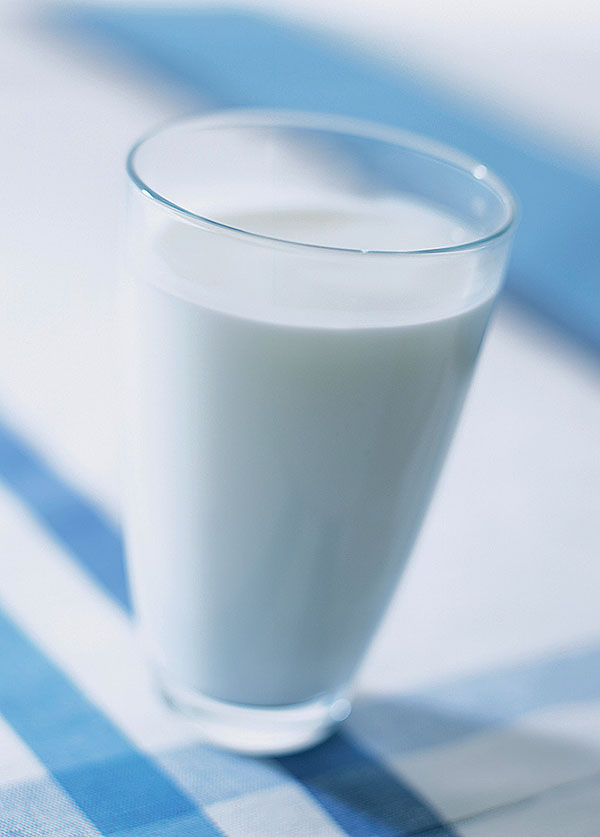milk | butter | kefir | cheese | yogurt | sour cream | buttermilk | sour milk | cottage cheese | curd | pudding
 Sour Milk – the First Dairy Product in the World
Sour Milk – the First Dairy Product in the World
We will probably never find out when it was discovered that ‘spoilt milk’ had a good taste and a long shelf-life, but in any case it was a very long time ago. We could say that sour milk was the very first dairy product in the history of mankind.
A Very Long History
The domestication of dairy cattle began around 10,000 years ago in warm climate areas. Originally, cattle were raised for their meat and hides. Milk was added to the benefits later.
Milk from domesticated animals (originally from goats) was consumed fresh or it was allowed to ferment in earthenware. As cattle breeding developed, produce from other milkers was added to goat’s milk.
The original fermentation of milk was more an inevitability than a foresight because it was the only way of keeping milk fresh in a warm climate for a long time.
The micro-organisms of milk performed as the original starter. Unfortunately, it was also difficult to stop milk fermentation in hot climate, so it fermented completely and contained too much lactic acid in the end.
The Progress Story of Sour Milk and its Ongoing Popularity
Originally, fermentation happened absolutely by accident, but soon pragmatic people started to make simple but important observations. They discovered that fresh milk fermented faster and better if some fermented milk was added to it. Usually they used a special fermentation container, and when the fermented milk was poured out they replaced it with the fresh one.
So over time, various starters were created either by accidental or informed choices that fostered the fermentation process and laid the foundation for the creation of various fermented milk products.
Hence the explanation of why various fermented dairy products with different textures, smells and tastes made from the milk of different animals are so valued in different countries. The difference between various types of fermented milk is illustrated by the fact that in various regions of Scandinavia various types of drinks with different composition are valued. In Sweden, people like sour milk with very thick curds that almost resemble jelly. Danes prefer an even thicker type – their national sour milk resembles a mixture of sour milk and curd paste. Finns, on the other hand, choose to drink the ordinary sour milk (in our terms) that was and still is popular in Estonia as well.
Local types of sour milk in the Caucasus region differ from each other by their more or less sharper taste and the level of natural carbonisation.
Sour milk was used as food in a variety of ways in Estonian farm households. The simplest way was to drink sour milk when eating porridge or bread. Unfortunately, sour milk was scarce as cows milked little and the milking period didn’t last long. Sour milk was usually mixed with water to dilute it. When eaten together with porridge, sour milk was served in a separate bowl and the eaters dipped the spoonfuls of porridge into it.
Fermented dairy products are popular for a good reason. They have a nice distinct taste, smell, texture, and dietary and healing properties. The taste of milk changes during fermentation, and new aromas are generated that foster the use of sour milk as a food product too. It was also important that during fermentation the consistency of milk became thicker, so a drink turned into a more solid food. The selection of different types of sour milk is wide.
Advantages of Sour Milk
In general we may say that all the types of sour milk are easy to digest and the human organism assimilates them well. Furthermore, they improve appetite, stimulate the functions of the pancreas and the liver and the secretion of bile.
And there are more benefits. The milk proteins of sour milk are partially curdled due to the acidic environment, so they are readily digestable, that means the amino acids in their composition are absorbed well into our bloodstream. This can be called external preliminary digestion, something that doesn’t diminish the biological value of proteins as their amino acid content doesn’t change.
The protein content of sour milk manufactured in Estonia is usually 2.9%. The somewhat altered state of milk casein due to the activity of living lactic acid bacteria reduces the possibilities of allergenicity. Compared with the proteins in fresh milk the proteins in fermented dairy products cause fewer allergic reactions.
The advantage of the commercially manufactured sour milk with 2.5% fat content is also that, even if a lot is consumed, it doesn’t give a lot of food fats or calories – the human body gets around 50 calories from a 100-gram portion of the product. At the same time, the fat content of sour milk is sufficient to ensure the absorption of the necessary micronutrients from the product and to give the product flavours that are palatable to many people.
As in the case of other fermented milk products, we should stress the suitability of sour milk for people who have problems digesting milk sugar. The lactose content in sour milk is lower, and the lactic acid bacteria consumed together with sour milk help to partially cleave lactose.
The carbohydrate content of the 2.5% sour milk that is on sale in Estonia is around 4%. The human body gets micronutrients from sour milk as well. Speaking of minerals, sour milk contains a considerable amount of calcium, potassium, magnesium, phosphorus, sulphur and sodium compounds. We get a small amount of microelements such as selenium, zinc, molybdenum, cobalt and iodine from sour milk.
Regarding vitamins, sour milk mainly contains various vitamins of the B-group (notably vitamins B2, B5 and B12): some of them come from the original milk and some are generated by the living lactic acid bacteria.
There are some additional bonus features. Lactic acid in the composition of fermented milk products stimulates the functions of various digestive glands, so it fosters the digestion process. The regular consumption of sour milk also improves the function of the intestines, helping to avoid constipation.
When drinking sour milk that has not been pasteurized the gastrointestinal tract of the consumer is enriched with lactic acid bacteria to a greater or lesser extent. The use of probiotic bacteria in the starter of the sour milk is especially beneficial as they also contribute to improving the health of consumers. The bacteria in a certain selected starter can produce compounds in sour milk that have an antibiotic effect. Sour milk with this composition is recommended in several special diets.
Applications of Sour Milk
One widely spread dish made from sour milk was liquid flour gruel. Cold or warm gruel cooked from barley or rye flour was added to skimmed sour milk (butter was made from the milk fat). The gruel and sour milk mixture was often allowed to ferment further. The gruel and sour milk drink was used as a thirst quencher, eaten with other dishes or as a food on its own. This food combined animal (sour milk) and vegetarian (cereal flour) components that made up a rich and diverse meal.
Rye flour was preferred as the flour component in this dish. The mixed drink made from rye was easier to drink and it fermented quickly. In various regions the sour milk and cereal flour mixed drink had different names. Sour milk and flour mixtures were preferred for two reasons. Firstly, their nutritional value was higher than of the sour milk alone, and secondly, they tasted better. Sour milk was the main ingredient when making kama, the traditional Estonian meal containing milled rye, wheat, barley and peas.
In old times, sour milk was also combined with a broth made from groats. They made a thick groats porridge first, then poured fresh milk over it and allowed it to ferment. When the mixture tasted sour it was mixed thoroughly and the liquid on top was used as food. On the farms, sour milk was also used in bread doughs for fostering the fermentation process – especially in winter when it was cold.
They started to use sour milk and baking soda as raising agents in the composition of various doughs and batters (for example in barley bread) very much later on. In particular, when mixing sour milk and baking soda, carbon dioxide is released that helps the dough to raise.
Making Sour Milk at Home
Nowadays, there are two ways to get sour milk – you can either buy sour milk manufactured by dairy industries from a store, or you can make it at home yourself. But we should keep in mind that milk in a closed package with the use-by date passed, or that has been kept in non-compliant conditions doesn’t ferment into sour milk at all. All you will find in the package is a liquid with an unpleasant smell and a disgusting taste.
You can make sour milk from raw milk at home. In this case the fermentation process takes place spontaneously if the conditions are right. You can add the starter with lactic acid bacteria to get a good result. A starter should also be used if you want to ferment pasteurized milk.
You can use either a special starter or milk products that contain living lactic acid bacteria for this purpose. You should add about 5% of this product (sour cream, fermented buttermilk, sour milk, etc.) to the original milk that you want to ferment. You should warm the milk to 20–25 °C first, add the starter, and mix the two carefully.
After a while when curds with a suitable thickness have formed, you should cool the sour milk quickly, either stirring it or not. Sour milk should be stored at a cold temperature, as the lactic-acidic fermentation activates quickly in warm places, and as a result, two unfavourable changes may take place in the product over time: the product becomes too sour to the palate, and it may not suit those people who cannot consume sour drinks due to inflammatory processes in the gastrointestinal tract.
Sour milk that has fermented too long doesn’t suit the diet of infants either. If the environment becomes too sour, the lactic acid bacteria start to die gradually and the microbiological value of the product decreases. The product may also stratify into two phases in case of excessive acidification: the protein- and fat-rich layer on top and the aqueous phase at the bottom.
You can increase the nutritional value of sour milk made at home or bought from a store by adding sugar, jams, mueslis and kama-meal to it, or by using it as a component when preparing other dishes such as doughs, batters or marinades.
The quality of sour milk or a product made from sour milk depends on various factors, the most important of which are the following:
- The composition and quality of the original milk
- The duration and temperature of the fermentation process of the original milk
- The quantity and composition of the starter
- The acidic content of the product and circumstances that can influence it
- The oxygen content of the product
- The storage temperature of the product during its shelf-life
The flavour of sour milk drinks mostly depends on the ingredients used
and their quantities.
Share ►


